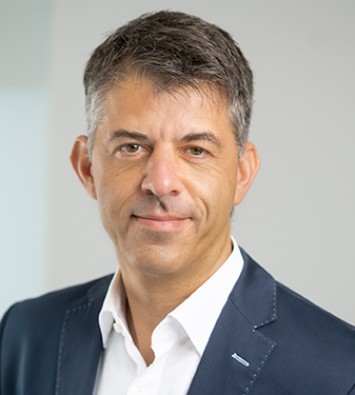Daily press, 2023-09-28, 10:00 am
New ship unloader at the Port of Rotterdam will ensure more efficient raw material supply for the Duisburg steel location from the end of 2025 onwards
- thyssenkrupp Steel Europe invests millions in a modern ship unloader
- Ship unloader sets new standards in efficiency and environmental friendliness
- Handling capacity of 24 million metric tons of raw materials secured for future green steelmaking in Duisburg
- Signal for the future of EECV and thyssenkrupp Veerhaven
Rotterdam, September 28, 2023. thyssenkrupp Steel is investing in modernizing terminal operations at Ertsoverslagbedrijf Europoort C.V. (EECV) at the Port of Rotterdam. With the investment of a mid-double-digit million euro sum, an old ship unloader will be replaced by a state-of-the-art one, strengthening the future of EECV and thyssenkrupp Veerhaven. The new unloader will significantly improve efficiency, environmental friendliness and safety, and is expected to be operational by the end of 2025. This underlines thyssenkrupp Steel's commitment to a modern infrastructure in the Port of Rotterdam, and sustainable supplies to thyssenkrupp Steel and Hüttenwerke Krupp Mannesmann (HKM) in Duisburg.
Investment in new ship unloader for the Port of Rotterdam
Day in, day out, four powerful grab cranes at EECV's terminal in the Port of Rotterdam will lift iron ore and coal out of the bellies of the large bulk freighters for steel production in the Ruhr region. One of them is rather old, and will now be replaced by a modern, highly efficient ship unloader. The amount of the investment decided by the shareholders is in the mid-double-digit million range. The project sends a strong signal for the future of EECV and thyssenkrupp Veerhaven, the two Dutch logistics subsidiaries of thyssenkrupp Steel. In the case of the bulk handling facilities of EECV, HKM is also a shareholder. Together, the two companies will ensure the unloading of seagoing vessels and the interim storage and transport of around 24 million metric tons of iron ore and coal for steelmaking in Duisburg, 365 days a year.
Securing raw material supplies for the future installation for direct reduction of iron ore by means of hydrogen
The successful work of the two companies will continue into the future – also thanks to Brussels having approved funding of the "tkH2Steel" decarbonization project by the German government and the state of North Rhine-Westphalia. "The amounts of coal being transshipped will gradually decline from 2027 onward, but iron ore will still be needed for the production of climate-friendly steel. As a result, EECV and thyssenkrupp Veerhaven will transport the raw material for the new direct reduction plant in the future. With the new ship unloader and the proven push boat fleet, both companies will continue to ensure a reliable connection between the Port of Rotterdam and the green steelworks in Duisburg over the coming decades," says Dr Heike Denecke-Arnold, Chief Operations Officer (COO) at thyssenkrupp Steel.
Modern ship unloader: efficient and environmentally friendly raw material supply
Like its predecessor, the new ship unloader weighs around 2,000 metric tons, stands a good 60 meters high, 30 meters wide and has a crane boom length of around 100 meters. With these crane dimensions, EECV will be able to unload the largest bulk freighters in the world at a highly productive rate of up to 2,600 metric tons of iron ore per hour. The crane will set new standards in environmental friendliness and energy efficiency. To effectively reduce possible dust emissions, the unloader will be equipped with a water spraying and misting system in the bunker area. Noise emissions will be kept below the officially approved limits. Occupational safety and comfort for employees will also be significantly improved. "With the new crane, we are investing in the future of EECV and the security of raw material supplies for thyssenkrupp Steel and HKM. It will give us the flexibility to further develop our business as we move forward with phasing out coal from 2027 onwards," comments Frank Tazelaar, CEO of EECV and thyssenkrupp Veerhaven, summing up the situation. EECV will select the supplier of the new unloader in the coming months. The new unloader is expected to go into operation at the end of 2025.
Investments in flexibility and sustainability strengthen forward-looking port infrastructure
Last year, thyssenkrupp Steel had already begun to explore developing hydrogen supply chains together with the Port of Rotterdam as part of its green transformation. Hydrogen is needed in large quantities for climate-friendly steel production, and could be transported via pipeline corridors from Rotterdam to Duisburg. With the new ship unloader, thyssenkrupp Steel is now sending out a further signal about the modernization and continuity of its infrastructure at the Port of Rotterdam.
EECV and thyssenkrupp Veerhaven will ensure uninterrupted raw material supplies
Since 1970, EECV has operated one of Europe's largest and most modern bulk handling facilities in the Europoort area of the Port of Rotterdam, as well as the second largest bulk terminal at the Port of Rotterdam, with around 300 employees. At the terminal facility covering an area of almost 100 hectares, the four ship unloaders at the 1.1-kilometer-long quay for seagoing vessels remove 30 to 40 metric tons of iron ore and coal from the ships with each lift. The raw materials are then transported to the storage areas via conveyor belts. The fleet of 7 wholly owned vessels, operated by push boat shipping company thyssenkrupp Veerhaven (approx. 200 employees), bring the raw materials for steel production around the clock from Rotterdam up the Rhine to Duisburg.





